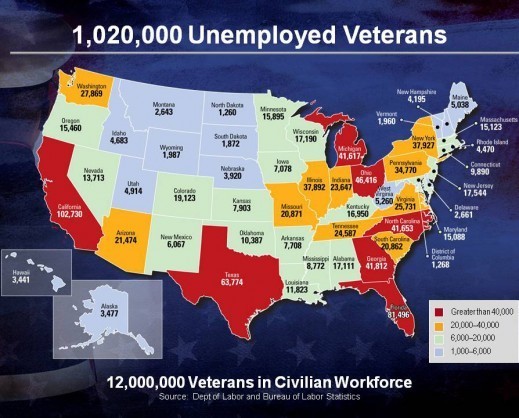A year ago, the unemployment statistics for returning veterans was substantially higher than the national population’s (which itself was already high).
In the months since, however, unemployment amongst America’s returning heroes has fallen significantly. Although the unemployment stats for post-911 vets still stands at over 10%, the number for all veterans hovers around 6.3%, compared to the national average of 7.9%.
These are encouraging numbers.
However, when you consider the incredible sacrifices that these uniformed men and women made for our country – it’s clear that we still have a long way to go. Ideally, the number should be 0%.
At US Solar Institute, we don’t see any reason why it can’t be.
But first some background.
Fortunately, the government has taken many proactive steps to reverse these unemployment statistics. In fact, it’s partially through federal programs like the GI Bill and the Veterans Retaining Assistance Program (VRAP) that we have witnessed such a major decrease in unemployment numbers that disproportionately affected our military veterans.
These programs have helped (and continue to help) tens of thousands of returning soldiers:
- secure training in today’s increasingly competitive marketplace
- cover tuition and travel costs
- provide stipends and living expenses
We’re moving in the right direction.
Limitations of Veteran Unemployment Programs
The overall trend is positive. But even programs as comprehensive and well intentioned as the GI Bill and VRAP are not entirely without their limitations.
For example, veterans must meet any number of requirements to qualify for educational assistance.
Being honorably discharged is a no-brainer. But sometimes, there are age requirements and other disqualifiers that don’t necessarily reflect one’s commitment to our country or one’s worthiness for additional training.
- To qualify for VRAP, for example, you must be between 35 and 60. So many of our returning heroes are in their young 20s, some having missed out on college to serve their country.
- Another disqualifier? You must be unemployed. On the surface, this makes sense. But if you only work 30 minutes per week, then technically you’re not eligible. There’s a lot of room between full-time employment and 100% unemployed – a fact that many programs overlook.
Even those who do qualify face obstacles in their quest to get retrained for the jobs of tomorrow.
For example, many veterans can’t afford to attend school full-time – even with generous assistance from the government. With family dependents, credit card debt, hospital bills – devoting 2 or more years to higher education is simply not feasible.
Vets in this category need jobs ASAP, making traditional GI Bill standbys like nursing, IT, and automotive technology beyond reach.
Solar PV Installation Training – Fast-track to Long-term Employment?
Solar PV installation is a relatively new category in the VRAP-approved list of career training fields. In fact, USSI only received approval to begin offering solar installation training this year – and we were the very first program approved in the entire world.
Besides saving the planet, one of the beauties of this field is the speed with which you can secure career-ready skills and join the professional workforce. Whereas nursing and most IT fields can take 24+ months to complete, a Department of Education-licensed solar PV diploma can take under 1 month.
For those who want only the most basic training, you can secure a certificate in under 1 week. This means that under the absolute best case scenario, you could hypothetically:
- enroll on Sunday
- graduate on Saturday
- start your job on the next Sunday
Now obviously, it’s not that quick. You probably wouldn’t even have time to search for a job during the 40+ hours of intensive coursework.
But still – your prospects are pretty good. That’s because solar energy is one of the few industries that has actually been “adding jobs” during this depressed economy – sometimes by a factor of 10:1 compared to the national average for most other sectors.
If you’re an unemployed veteran (or you know one), and you’re looking to get back into the workforce with advanced skills, solid pay, and minimal downtime – solar PV installation training is definitely worth considering.
Contact us to learn more.

